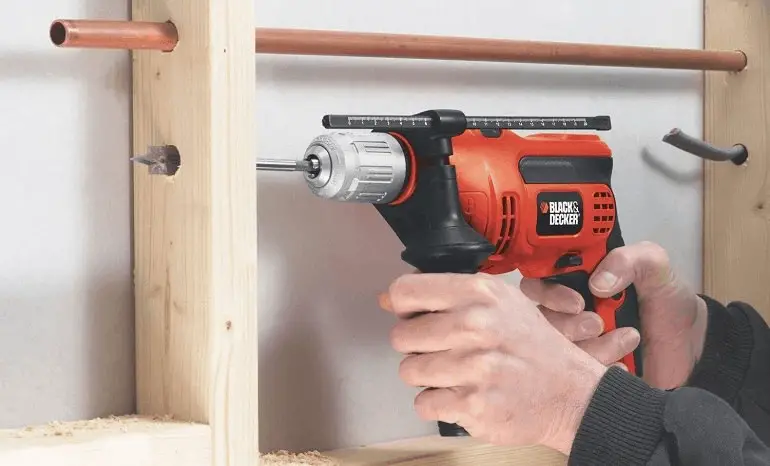Regular drills lack the power for heavy-duty works like drilling into stone, masonry, and concrete surfaces. Unlike a cordless drill that only spins, a corded hammer drill spins and hammers concurrently enabling it to dig deeper.
A corded hammer drill is specifically designed to drill into concrete and masonry surfaces by providing the unrivaled power to see you through the task. A cordless drill lacks this power as it uses batteries that might run out before you complete the task. These corded drills will see you smoothly through projects that would otherwise prove to be difficult for a drill or hammer on its own. We share with you the top 5 reviews and what to look for when purchasing one.
Best Corded Hammer Drill – A Comparison Table
| Model | Features | Check on Amazon |
|---|---|---|
| Bosch 11255VSR Rotary Hammer Power Drill | The best overall corded hammer drill | Check Price |
| TACKLIFE PID01A Corded Hammer Drill | Best tight spaces | Check Price |
| Skil 6445-02 Hammer Drill | Value for money | Check Price |
| ENEACRO ENRH3203 Heavy Duty Rotary Hammer Drill | Best for heavy-duty | Check Price |
| DEWALT DW511 Hammer Drill | Best for light-duty | Check Price |
Bosch 11255VSR Rotary Hammer Power Drill – Best overall corded hammer drill
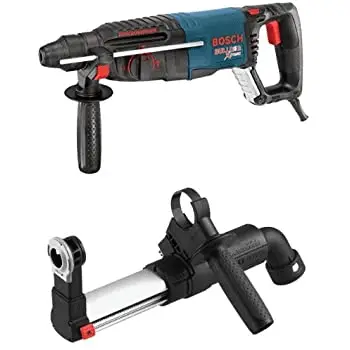
For the kind of drilling a hammer drill is subjected to, this hammer drill by Bosch can handle heavy-duty applications like pulling up thick concrete or removing mortar from concrete. It’s more of a jack-hammer than a standard drill and is reasonably priced. It has 3 different settings that include a rotary hammer, hammer, and standard drilling that varies in speed according to how hard you press the trigger. It’s 17 inches long and weighs 4.28 pounds and isn’t the best if you work in tight spaces. It has a D-shaped handle that makes it easier to hold and a secondary handle to enable you to control the drill when at work. The cord turret has a 35-degree pivot to reduce wear and tear, and a Vario-Lock feature that enables the chisel to lock into any one of the 36-position settings and rotate providing you with versatility when working in tricky angles.
Its greatest selling point is power. It delivers 2 foot/pounds torque and a maximum speed of 1300 RPM powered by a 7.5 Amp motor that allows you to drill in reverse or forward guaranteeing the same performance. It also comes with an SDS-plus bit system that you can use to tighten or loosen the drill bits automatically.
Pros
- It offers three drilling functions
- It comes with a Vairo-Lock feature that allows you to rotate the drill in several positions
- It’s excellent in pulling up stone slabs or concrete
Cons
- It’s very long and requires space to use it
View price on Amazon
TACKLIFE PID01A Corded Hammer Drill – Best tight spaces
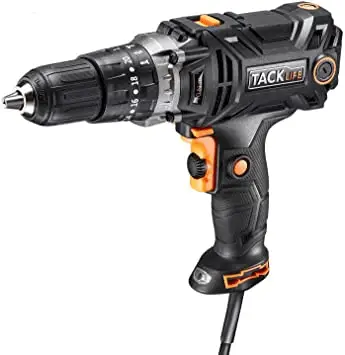
TACKLIFE PID01A Hammer Drill combines a standard drill with a hammer action which you can easily switch in between using a button depending on the task at hand. It uses 6 Amps to power twelve different speeds of up to 2800 RPM that you can choose from using a simple dial based on your job. It weighs 4.28 pounds, has a plastic handle and a lock-on button to enable you to turn the drill without having to keep on pressing it, minimizing fatigue on your wrists and hands. It comes with an auxiliary handle that can rotate through a 360-degree angle that makes it easier especially in tight spaces to get the right angle making it compact. For drill bits, it has a sturdy metallic chuck of up to ½ an inch that can go both forward and in reverse meaning that you can use it as an electric screwdriver. Besides, it comes with a set of drill bits, a depth gauge, and a chuck key.
Pros
- It can fit in tight spaces
- It offers standard drilling and hammer functions in one
- Its competitively priced
- It has 12 different speeds
Cons
- It may need an extension cable because it’s short
- It can’t handle reinforced concrete
- The chuck is not very secure
View price on Amazon
Skil 6445-02 Hammer Drill – Value for money
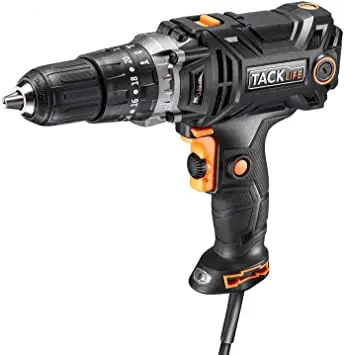
If you want to save a few bucks without having to compromise on power, then SKIL 6445-04 Hammer drill is a top contender. It has a 7 Amp motor that drives the drill with a maximum of 3000 RPM and a responsive trigger that provides you with varying speeds at ease, weighs 5.6 pounds, and is slightly above 13 inches long. The ½ – inch chuck is compatible with drill bits with bigger diameters for cutting and woodworking and you’ll require a key to adjust it. It includes an auxiliary handle which is easier on your arms to aid you in controlling and rotating the drill at any angle. It comes with two modes – hammer and standard drill mode and you can remove the screws by reversing it. It however does not include drill bits which you will need to order separately.
Pros
- It’s easy to use and maintain
- It offers a lot of power
- Its value for money
Cons
- It can be difficult to read in some positions when you turn the auxiliary handle
- It has a short cord and you may need to use an extension cable
- The chuck is a keyed one
View price on Amazon
ENEACRO ENRH3203 Heavy Duty Rotary Hammer Drill – Best for heavy-duty
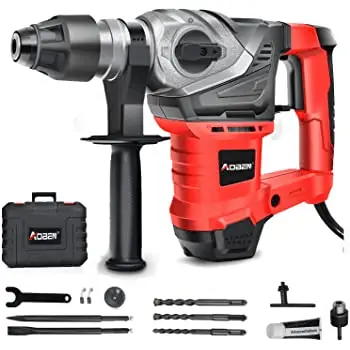
This drill is a beast doing what smaller drills can’t do. It can act as both a powerful drill and a jackhammer with its 3 modes, namely drill, hammer drill, and hammer modes. It has a powerful 12.5 Amp motor with a 5.2 feet/pounds torque, a maximum speed of 880 RPM, and 4350 BPM that can power through heavy-duty concrete and metal applications easily and with precision. Besides, it has a double function switch to switch between various work scenarios. It takes care of your arm, hand, and wrist with a safety clutch and a 360-degree adjustable handle. Also, it comes with a double anti-vibration layer to give you more stability when holding it. The SDS-Plus chuck can hold a maximum drilling capacity of 1-¼ inches for concrete and ½ inches for metal securely. It also comes with a carbon brush, a dustproof cap, 2 chisels, an auxiliary handle, and a 2-year warranty.
Pros
- It’s powerful and can handle heavy-duty projects
- Its relatively cheap
- It has 3 different modes that you can switch between
- It comes with extra components
- It has a sturdy construction for durability
View price on Amazon
DEWALT DW511 Hammer Drill – Best for light-duty
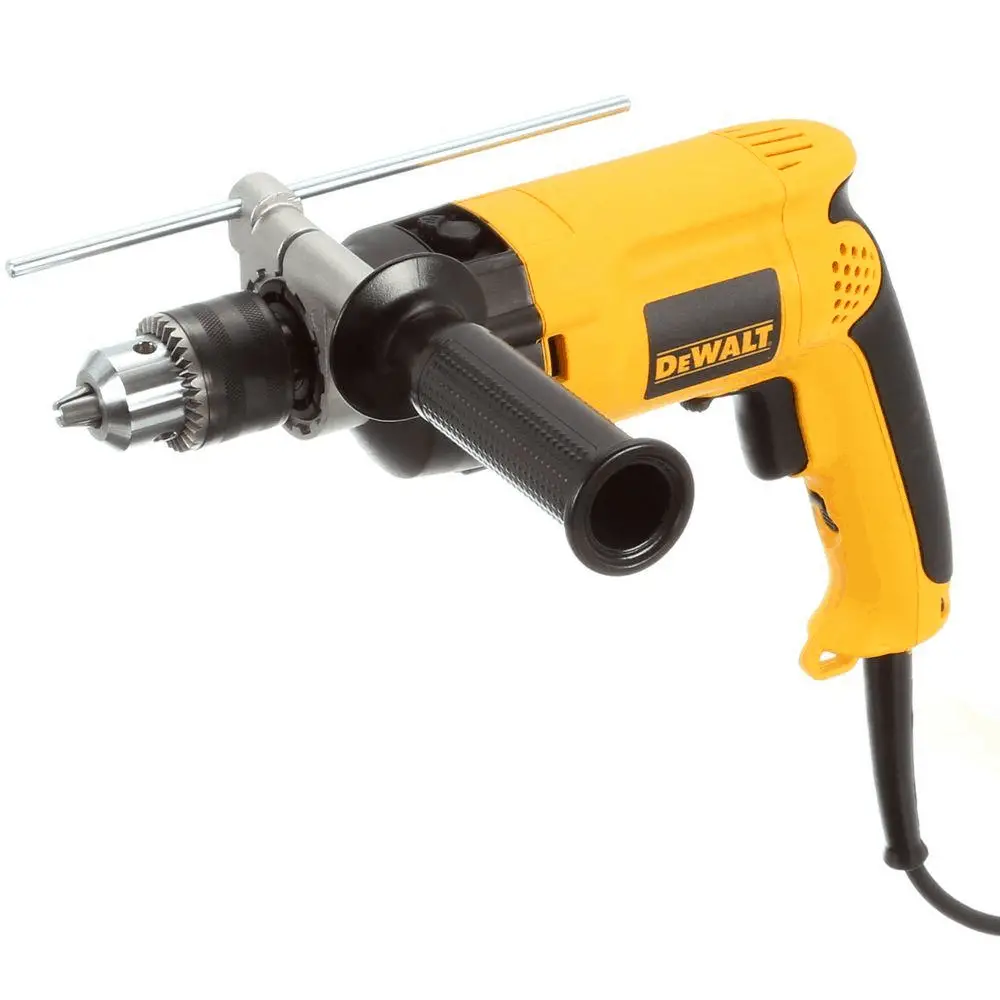
The Dewalt DW511 hammer drill is a great hammer drill with a powerful 7.8 Amp motor delivering more than enough power for a wide array of jobs including concrete, wood, and even steel. It’s fairly lightweight weighing 4.3 pounds and comes with a trigger for variable speed that puts the control in your hands to achieve the precision required. Also, there’s an adjustable depth rod that you can use to get the desired depth. It also has a 360-degree side handle that allows you great precision for depth and control. The maximum drill bit diameter is ½ an inch and the chuck is keyed. It comes with extra components including hammer drills, power drills, and power hammer drills.
Pros
- It’s lightweight and compact
- It has a powerful motor of 7.8 Amp with variable speed control
- It comes with a Depth rod and a 36-degree side handle
Cons
- The handgrip is rubberless
- The chuck is keyed
- It gets hot fast
- It’s not ideal for heavy-duty tasks due to limited power
View price on Amazon
What to consider when buying a corded hammer drill
Power
Power is the most important consideration since it directly affects a corded hammer drill’s performance. You should ask yourself, what are you looking to drill, is it a stone or brick wall, or a thick concrete slab? The more power it can yield, the more it can do even drilling deeper in the toughest surfaces. The lowest significant power level is 5 Amps which should be enough to not only drill sets fixtures but also a satisfactory depth for most projects. A hammer drill with less can be able to complete most projects but at a slower rate with the depth being shallower. A 7 Amp or more hammer drill is ideal and you will get through projects faster and easier.
Motor
Hammer drills come with brushed or brushless motors. A drill with a brushless motor keeps the drill cooler than a brushed one making it more durable.
Speed
Hammer drills’ speeds are measured in three different ways – torque, BPM (blows per minute), and RPM (revolutions per minute). The drill torque determines the speed and power with a higher torque translation to a more powerful hammer drill. Different applications require a different drill speed with some using a slower instead of a faster drill speed to increase precision and penetration. To control and adjust these speeds, most hammer drills come with a trigger that responds to the amount of pressure exerted and mostly comes in handy if you don’t have a free hand to adjust the drill’s speed. or variable speed setting that looks like a dial with numbers ranging from 1 to 3 with 1 being the least. For professionals, a hammer drill with a trigger is more preferable.
Versatility
Most hammer drill models come with a switch that allows you to toggle between different modes on the go allowing you to switch from a standard drilling mode to a hammer mode. Others offer more than 2 modes giving you the versatility you need to toggle between DIY tasks and professional ones.
Ease of use
The ease of operating a hammer drill is vital especially if you’re a newbie since you can get off the ground more easily and faster. Also, the type of chuck makes a difference too. For an experienced driller, you would prefer a keyless chuck drill that allows you to spin and lock the bits in place. Most models however use a keyed chuck which holds the drill bits in place way better and comes in handy when drilling into metal or masonry but is inconvenient when replacing the drill bits. When it comes to the depth gauge, most hammer drills require you to release the chuck when adjusting the depth gauge which is not easy. The best hammer drills are the ones that allow you to change the drill bits and depth gauge independently since you get to save on time and hassle.
Chuck
All drills come with different chuck sizes that are normally interchanged with their names. Chuck size illustrates the drill capacity with bigger drill bits not being able to fit onto smaller size chucks. For example, a ¼-inch chuck can’t accommodate a drill bit with a diameter of ⅜ inches. Heavy-duty tasks usually use bigger drill bits and need chucks with a bigger diameter which makes them more powerful.
Comfort
Because you will most likely use a hammer drill for long hours, it’s good to choose one that won’t leave you fatigued sooner. Check one with a good handle design like soft rubber and weight that you can handle that will leave your wrists, hands, and arms fatigue-free.
Frequently Asked Questions (FAQs)
What’s the ideal extension cable length for a hammer drill?
When working with a corded drill that comes with a 6- 8ft cord length at most. You will need an extension cord to increase the length while working. An extension with at least 25ft is ideal with the most important thing being that you ensure it’s a solid one for safety to handle a heavy-duty appliance.
Is there a difference between an impact driver and a hammer drill?
The main difference between the two is the direction from which they exert additional force during twisting action. An impact driver increases the force delivered perpendicular to the drill bit while a hammer drill exerts more force directly into the drill bit whilst hitting the material it’s drilling.
Conclusion
Hammer drills are designed for heavy-duty jobs that are beyond standard drills and offer several modes that you can switch between. Consider the corded hammer drills in this list when you go out to buy one and use the above buyer’s guide.
